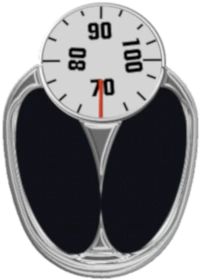What is Ideal Wheight?
 Normal weight is the range that is considered healthy under normal circumstances. According to the WHO classification, a BMI between 18.5 and 24.9 represents normal weight. It covers a more or less wide range between underweight and overweight.
Normal weight is the range that is considered healthy under normal circumstances. According to the WHO classification, a BMI between 18.5 and 24.9 represents normal weight. It covers a more or less wide range between underweight and overweight.
The ideal weight is the weight which is exactly in the middle between underweight and overweight.
When it comes to weight, most people think of attractiveness and beauty. However, there are no exact definitions for these two terms because they are subjective desires. In colloquial language, it refers to an ideal of beauty. The focus is usually more on aesthetic appearance than on health.
If you want to find out your ideal weight, you need to know your ideal BMI.
In addition to your height and weight, our free BMI Calculator takes your gender and age into account. The terms ideal weight and desired weight describe approximately the same thing. This weight also takes into account aesthetic aspects. These terms describe a desire that is influenced by external factors, among other things.
The term ideal weight was not always subjective. In the information brochure Living longer with diet published by the German Federal Ministry for Youth, Family and Health in 1970, the ideal weight was defined as the exact average between minimum weight and maximum weight.
| Body Height | Minimum Weight | Maximum Weight | Ideal Weight |
|---|---|---|---|
| Women | |||
| 170 cm | 55,5 kg | 64,5 kg | 60,0 kg |
| 180 cm | 61,8 kg | 72,1 kg | 67,0 kg |
| Men | |||
| 170 cm | 60,4 kg | 72,3 kg | 66,4 kg |
| 180 cm | 67,2 kg | 80,3 kg | 73,8 kg |
Source:
Living longer with diet, German Federal Ministry for Youth, Family and Health, Germany, Bamberg 1970
At that time, people were mainly guided by normal weight and ideal weight according to Broca’s formula. The main advantage of this formula is the fact that you can easily determine both your normal weight and your ideal weight using mental arithmetic. The disadvantage that this formula cannot be used for very short or very tall people can usually be ignored, because not very many adults are shorter than 1.55 m or taller than 1.85 m.
For adults with a particularly muscular build, the WHtR (Waist to Height Ratio) is more appropriate, as it takes into account body shape and body fat distribution. Muscular people (e.g. athletes) are almost always misclassified by BMI. Being overweight is not determined by muscles, but by an excessive amount of body fat.If you agree with the idea that the ideal weight is the weight that promises maximum life expectancy, then being slightly overweight with a BMI between 25 and 27 is recommended. This is the surprising result of a long-term Israeli study that observed 10,000 middle-aged men for four decades. But be careful: the body mass index says nothing about your stature. It is necessary to distinguish whether muscle mass or fat is responsible for the increased weight. In the first case, the term overweight is not useful.